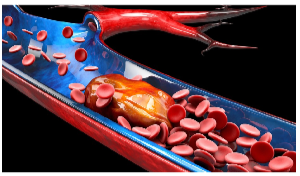In this section I want to talk about Blood Clots in the Calf (Deep Vein Thrombosis (DVT)). As a provider, I’ve witnessed and treated many patients with blood clots in their legs and calves (deep vein thrombosis (DVT)). These patients range from the young and athletic to the very old and chronically ill. No matter their health status and age, they all have said that the calf pain is the worst that they have ever felt. They report feeling cramping sensations and pain that persist and worsen with time. Stretching or “walking it off” like an ordinary charley horse will not ease DVT pain or clear it up.
Therefore, almost anyone can develop this serious and preventable disease, making it incredibly important to know the risk factors and warning signs if you or a loved one develops a DVT. When symptoms of DVT appear, they usually occur suddenly. Please seek medical attention as soon as you
identify anything out of the ordinary. Get immediate health attention if you have pain, swelling, and
tenderness in your leg and you develop breathlessness and chest pain as you may have a DVT that
developed into a pulmonary embolism.
To learn more about blood clots, please read the information below.
What are blood clots (thrombosis)?
● Blood clots are platelets, proteins, and cells that stick together.
● Occurs when a blood clot (thrombosis) forms in one or more of the deep veins in the body, usually the legs.
● Can causes leg pain and swelling
● Sometimes there are no signs and symptoms
● A very serious condition because clots can break off and travel through the bloodstream and get stuck in the lungs resulting in a pulmonary embolism (PE).
Causes
● Certain medical conditions that promote blood clotting
● Not moving for long periods of time
● Bedrest from an illness or surgery
● Fractures in the pelvis or leg
● Recent surgery (hip, knee, pelvis surgery)
● Damage to a vein from surgery, inflammation, infection, or injury
Signs and Symptoms
***Please follow up with your physician or general practitioner if you are having any of the symptoms listed below. More about Blood Clots in the Calf (Deep Vein Thrombosis (DVT))
● Leg swelling
● Leg pain
● Leg soreness that starts in the calf
● Changes in skin colors on the leg (red or purple depending on the skin complexion)
● The affected leg may feel warm to the touch
Diagnosis
● Physical exam by your physician or general practitioner
● Labs: D-dimer blood test to check for blood clotting issues
● Doppler Ultrasound to assess for a blood clot
Treatment
● Your physician will provide medicine (anticoagulants) to thin out the blood, to prevent more clots
from forming, and to prevent the old clots from sticking together and forming larger clots.
● First line of treatment (In the hospital): Heparin given intravenous (through the veins)
● Low molecular weight heparin given by injection under the skin once or twice per day
● Other forms of anticoagulants (Outpatient clinic)
○ Coumadin
○ Xarelto
○ Eliquis
○ Pradaxa
● A surgeon may place an Inferior Vena Cava Filter (IVC Filter), a small, metal device designed to trap large blood clots and prevent them from traveling into the heart and lungs in the body’s largest vein to prevent blood clots from traveling to the lungs.
● A surgeon may remove larger clots from the vein or inject medication to break up the clot.
Complications
● Pulmonary embolisms (PE) are fatal
● Constant pain and swelling in the legs
● Varicose veins
● Skin changes color
Prognosis
● Clots often go away without problems, but they can also return.

References
CDC. (2022). What is Venous Thromboembolism? https://www.cdc.gov/ncbddd/dvt/facts.html
John Hopkins Medicine. (2022). Deep Vein Thrombosis (DVT) / Thrombophlebitis. https://www.hopkinsmedicine.org/health/conditions-and-diseases/deep-vein-thrombosis-dvt-
thrombophlebitis
Josan, V. (2022). [3D Illustration]. Deep Vein Thrombosis or Blood Clots. Embolism.
https://www.shutterstock.com/image-illustration/3d-illustration-deep-vein-thrombosis-blood-1303476349
